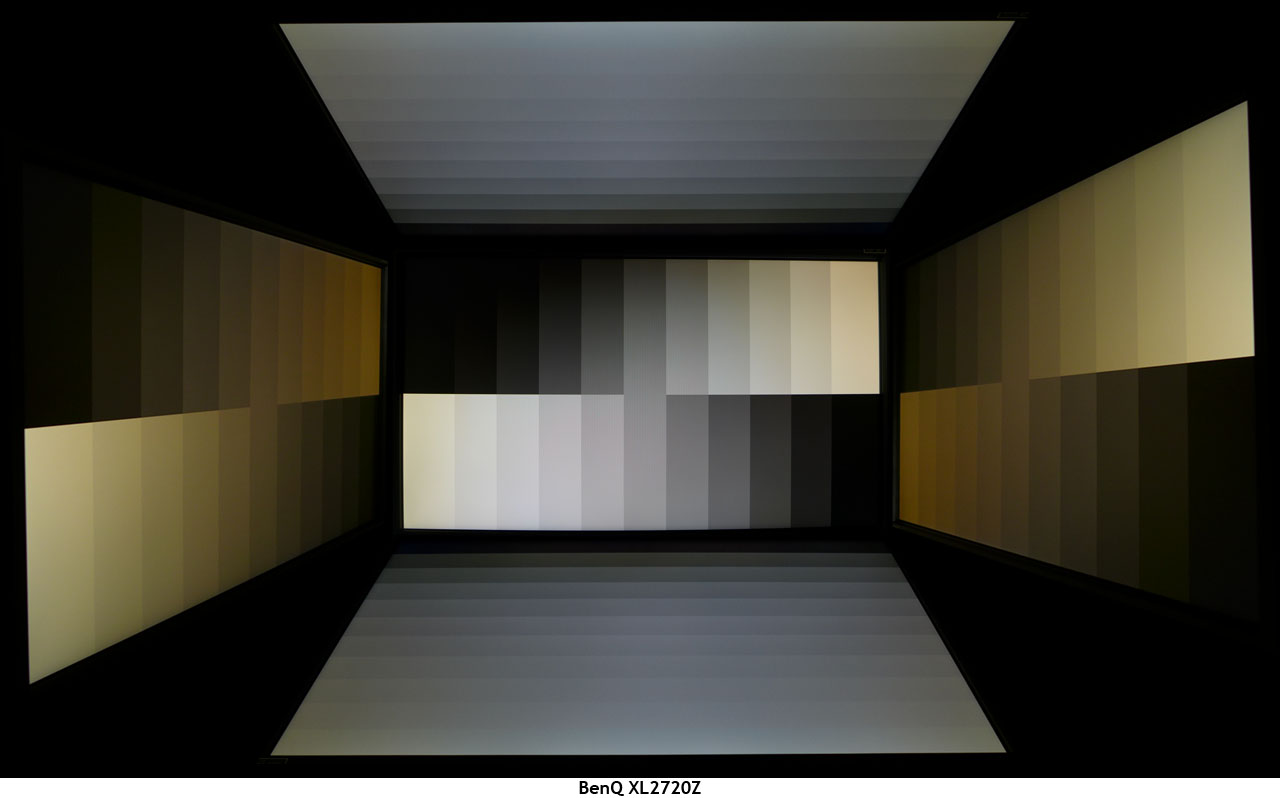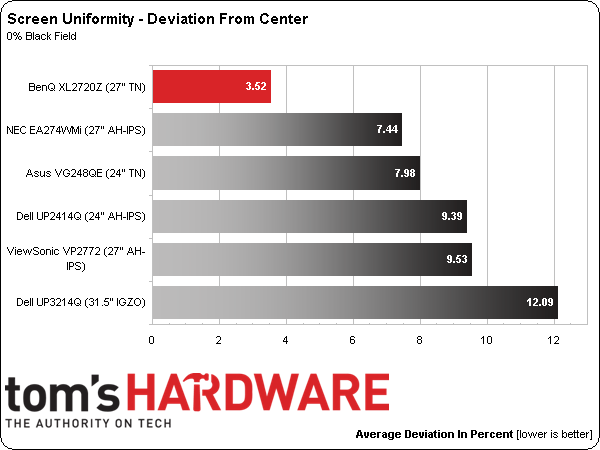BenQ XL2720Z Monitor Review: A 27-Inch, 144 Hz Gaming Display
Many displays are marketed as gaming monitors. But only a tiny handful operate at refresh rates greater than 60 Hz. The BenQ XL2720Z sails along at 144 Hz and offers many gaming-specific features. Today we run it through our benchmark suite.
Results: Viewing Angles And Uniformity
The more monitors we test, the more we can see that off-axis viewing performance is dependent not only on pixel structure (IPS, PLS, TN, etc.), but the backlight technology as well. And we can see that the anti-glare layer makes a difference too.
Off-axis image quality remains the weak point of TN screens. In our composite photo, you can see an obvious color shift towards red in the horizontal pictures. Even in the head-on shot, there is a slight tint due to the wide-angle lens on our camera. The vertical images don’t show any color issues, but detail in the 11-step grayscale pattern is almost non-existent. It’s very difficult to distinguish the brightness levels from one another.
Since gamers typically sit close to their monitors, 27 inches really does seem to be the practical size limit for a TN panel. If it were any larger, you’d see color tint and detail loss in the sides of your display, even from dead center.
Screen Uniformity: Luminance
To measure screen uniformity, zero and 100-percent full-field patterns are used, and nine points are sampled. First, we establish a baseline measurement at the center of each screen. Then the surrounding eight points are measured. Their values are expressed as a percentage of the baseline, either above or below. This number gets averaged. It is important to remember that we only test the review sample each vendor sends us. Other examples of the same monitor can measure differently.
First up is black field uniformity.
We haven’t tested many TN screens, but the two in this group acquit themselves very well. BenQ’s result is the lowest we’ve recorded to date. There’s certainly no uniformity compensation look-up table needed here!
Next is the white field measurement.
Get Tom's Hardware's best news and in-depth reviews, straight to your inbox.
The white field result is right about average for the displays we’ve measured. In the XL2720Z’s case, the center of the screen is slightly hotter than the surrounding zones. It’s extremely hard to see with the naked eye, though. If you could reduce that hotspot to equal the rest, the result would be closer to three percent.
Screen Uniformity: Color
To measure color uniformity, we display an 80-percent white field and measure the Delta E error of the same nine points on the screen. Then we simply subtract the lowest value from the highest to arrive at the result. A smaller number means a display is more uniform. Any value below three means a variation that is invisible to the naked eye.
The XL2720Z has excellent grayscale tracking, and that performance holds up at all points on the screen. There is no visible color tint anywhere, just a smooth white tone at all brightness levels.
Current page: Results: Viewing Angles And Uniformity
Prev Page Results: Color Gamut And Performance Next Page Results: Pixel Response, Input Lag, And Blur Reduction
Christian Eberle is a Contributing Editor for Tom's Hardware US. He's a veteran reviewer of A/V equipment, specializing in monitors. Christian began his obsession with tech when he built his first PC in 1991, a 286 running DOS 3.0 at a blazing 12MHz. In 2006, he undertook training from the Imaging Science Foundation in video calibration and testing and thus started a passion for precise imaging that persists to this day. He is also a professional musician with a degree from the New England Conservatory as a classical bassoonist which he used to good effect as a performer with the West Point Army Band from 1987 to 2013. He enjoys watching movies and listening to high-end audio in his custom-built home theater and can be seen riding trails near his home on a race-ready ICE VTX recumbent trike. Christian enjoys the endless summer in Florida where he lives with his wife and Chihuahua and plays with orchestras around the state.
-
Fierce Guppy What a coincidence. I got a XL2720Z just this Wednesday. I would've preferred to wait for the arrival of Haswell-E before buying a new monitor, but my Samsung T260 emits something that causes reddening of the skin around my nose, above my left eyebrow, and smack in middle of my forehead. (Sunlight and florescent tubes don't do this to me.) Happy to say the XL2720Z does not cause me any injury, or at least not yet...Reply
It's still an interim monitor, though. What I really want is a large affordable WQHD or UHD IPS gaming monitor.
-
MonsterCookie When do monitor manufacturers understand, that 1080p resolution is a JOKE,Reply
especially on a large 27" screen?
In the early 2000s it might have been ok to have such resolution, but nowadays
it is no longer usable. Even for a 24" screen the minimal resolution is
1920x1200.
Until they are not making these 27" screens to have more pixels, they are not
seeing any cash out of me. I rather buy el-cheapo monitors from Ebay as a mail
order from Korea.
Monitor manufacturers, please stop living in the 80s and stop hustling us with
your prices! -
Bernie Fresh "oh neat, a new monitor. lets check specs. oh coool 1080p and a bunch of buzz words"Reply
sometimes I feel like nobody is listening... or just trying to sell me a bridge for the low low.
decent review, but if youve got the gpu for 144Hz. 2160p @60 is just a cootie shot away -
somebodyspecial So from the results I still need an IPS with Gsync or you're stuck with TN. I'm hoping by xmas they have a dozen good choices for gsync monitors with 144hz also in there (why not, what if I go AMD again after maxwell?). Might as well get as many bases covered as possible. IF monitor makers are reading this, 2560x1600! Screw this 1440p crap. Wider is NOT better in monitors of these sizes. I want to scroll up & down less than I am already on 1920x1200 but at least at 1600p I get the same. I won't buy 1440p.Reply -
MonsterCookie Reply"oh neat, a new monitor. lets check specs. oh coool 1080p and a bunch of buzz words"
To add offense to injury, in 2008 I bought my first LCD (24" Samsung with 1920x1200 pixels) for 330Euros. Now a 24" Samsung would cost me 400 Euros, and it has only 1920x1080 pixels.
sometimes I feel like nobody is listening... or just trying to sell me a bridge for the low low.
What on earth have happened? Why did prices go up, and resolution went down?
Why are there no 30" 2560x1600 TN panels out there for gamers for 700 Euros?
-
siman0 ReplyWhen do monitor manufacturers understand, that 1080p resolution is a JOKE,
especially on a large 27" screen?
In the early 2000s it might have been ok to have such resolution, but nowadays
it is no longer usable. Even for a 24" screen the minimal resolution is
1920x1200.
Until they are not making these 27" screens to have more pixels, they are not
seeing any cash out of me. I rather buy el-cheapo monitors from Ebay as a mail
order from Korea.
Monitor manufacturers, please stop living in the 80s and stop hustling us with
your prices!
This monitor is made for gaming, true gamers don't care a grate deal about resolution. We are in it for the refresh rates and the response time. Ive been gaming on a old CRT monitor till last year with a change to the Asus VG248QE. Even though its still much slower than my old CRT it works. I have 2 computers 1 for gaming and one for everyday and video work. Gaming machine is set up around a single R9 290X, 4770K, and a Asus VG monitor. My other computer is a crossfired 295s, 3930K, and 3 IPS 4k monitors.
A single card is better for latency, 4770K is more than enough to push data to the 290X and the monitor has a fast refresh rate. Its better at gaming than my extremely high dollar build. Peripherals are set up differently as you can imagine gaming computer has razer and a 7.1 headset. The other is mostly set up for 2.1 but i do have a 7.1 headset for room sound. -
MonsterCookie @siman0Reply
"This monitor is made for gaming, true gamers don't care a grate deal about resolution"
You meant, online multiplayer gamers don't care a grate deal about resolution.
I prefer to play single-player FPS, where I do want to have all the eye candy,
and I want to see the vegetation, desert, sky etc. The only advantage of a PC is
that it can provide better graphics, that is the main point.
Otherwise I could just go out, buy an 1080p TV, a Crapbox1, Crapbox360, or PlayStopper 4, and game on that thing in 1080p.
I think monitor technology is not moving forward (in fact moving backwards) exactly because people are happy to buy their 1080p crap for 500 Euros. -
InvalidError This seems a little weird to me: the panel uses constant-current to drive LEDs because some people claim to see flicker at ~20kHz PWM frequency yet the very same display uses backlight strobing to reduce blur and this would be occurring at 144-288Hz which is 100X lower.Reply -
DookieDraws Serious question. Why not just buy a quality HDTV with 120 (or greater) Hz for your gaming monitor? Especially if you'll be gaming at 1920x1080. A neighbor has his PC hooked up to a quality HDTV and it looks great to me. I've played Battlefield on it with no issues at all. It's pretty awesome!Reply -
Fierce Guppy ReplyMonster Cookie:
When do monitor manufacturers understand, that 1080p resolution is a JOKE,
especially on a large 27" screen?
In the early 2000s it might have been ok to have such resolution, but nowadays
it is no longer usable. Even for a 24" screen the minimal resolution is
1920x1200.
In the early 2000s CRTs were still the standard. 4:3 was the standard aspect ratio. There were no 1080p LCD monitors let alone large 1080p LCD monitors, and I paid ~$1200(NZD) for a 17" 1280x1024@60Hz (16ms) LCD display in 2003. That's how bad it was back then.



